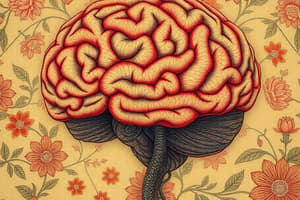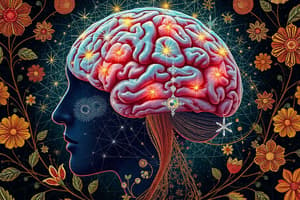Podcast
Questions and Answers
The evolution of learning theories follows a progression: Behaviorism -> ______ -> Constructivism -> Connectivism/Transhumanism.
The evolution of learning theories follows a progression: Behaviorism -> ______ -> Constructivism -> Connectivism/Transhumanism.
cognitivism
Thorndike’s Law of Effect states that responses to a situation that are followed by satisfaction are strengthened, while responses followed by ______ are weakened.
Thorndike’s Law of Effect states that responses to a situation that are followed by satisfaction are strengthened, while responses followed by ______ are weakened.
discomfort
MacLean's Triune Brain concept divides the brain into three parts: the Reptilian Brain, the Paleo-Mammalian Brain, and the ______ Brain.
MacLean's Triune Brain concept divides the brain into three parts: the Reptilian Brain, the Paleo-Mammalian Brain, and the ______ Brain.
Neo-Mammalian
Within the neuron, ______ are branchlike structures that receive messages from other neurons.
Within the neuron, ______ are branchlike structures that receive messages from other neurons.
[Blank] are chemicals that transmit messages between neurons.
[Blank] are chemicals that transmit messages between neurons.
[Blank] Neurotransmitters like GABA and serotonin serve to "cool" your central nervous system (CNS).
[Blank] Neurotransmitters like GABA and serotonin serve to "cool" your central nervous system (CNS).
Synaptic pruning refers to the weakening or ______ of synaptic connections.
Synaptic pruning refers to the weakening or ______ of synaptic connections.
Experience-expectant plasticity refers to the brain's ability to fine-tune its powers to adapt to ______, and is available from conception.
Experience-expectant plasticity refers to the brain's ability to fine-tune its powers to adapt to ______, and is available from conception.
Experience-dependent plasticity refers to the emergence of skills that are ______ to particular cultures and social groups.
Experience-dependent plasticity refers to the emergence of skills that are ______ to particular cultures and social groups.
Myelin, a fatty substance, speeds up ______ transmissions in the brain.
Myelin, a fatty substance, speeds up ______ transmissions in the brain.
Flashcards
What is learning?
What is learning?
A relatively permanent change in an organism that results from experience.
Reptilian Brain
Reptilian Brain
Controls basic survival functions like breathing and heartbeat, ensuring physical instincts.
Paleo-Mammalian Brain
Paleo-Mammalian Brain
Responsible for emotions, memory, and social bonding. The quality of memory correlates with social relationships.
Neo-Mammalian Brain
Neo-Mammalian Brain
Signup and view all the flashcards
Synapse
Synapse
Signup and view all the flashcards
Neurotransmitters
Neurotransmitters
Signup and view all the flashcards
Plasticity
Plasticity
Signup and view all the flashcards
Synaptic Pruning
Synaptic Pruning
Signup and view all the flashcards
Critical Period
Critical Period
Signup and view all the flashcards
Myelin
Myelin
Signup and view all the flashcards
Study Notes
How People Learn: Week One Summary
- Learning includes its definition and the various types of changes it may involve
- Learning principles compared to Learning Theories, the importance of the latter is highlighted
- Features a conceptual framework of theories of learning and their evolution
- Brain Development and the Nervous System covers the evolution of the brain via MacLean’s Triune Brain.
- Central vs. Peripheral Nervous Systems are explored
- Focuses on the nature and function of neurons and synapses.
- Key neurological phenomena: synaptogenesis, synaptic pruning, myelination, sensitive/critical periods, plasticity, and experience-expectant and -dependent learning
Conceptual Framework: The Evolution of Learning Theories
- Learning theory evolved: Behaviorism to cognitivism to constructivism to connectivism/transhumanism
- Behaviorism is learning like an animal, cognitivism is like a machine, constructivism like a human, and connectivism/transhumanism like a cyborg
Cognitive Neuroscience and Behaviorism
- Cognitive Neuroscience notes
- Behaviorism centers on environment and British Empiricism
- Learning is a function of contingencies, reinforcers and punishers
- Focuses on Classical and Operant Conditioning
Cognitivism
- Person (Continental Rationalism)
- Learning as a function of innate structures and internal processes
- Information Processing Theories
Psychological Constructivism
- Psychological Constructivism notes
- Social Constructivism notes
Principles: Definitions & Examples
- A principle is "an established relationship between factors"
- Thorndike’s Principle states a behavior followed by a satisfying state is more likely to increase in frequency
- Thorndike’s Law of Effect states responses followed by satisfaction are strengthened
- Responses followed by discomfort are weakened
Theory Definition
- A theory is an "integrated statement of principles that attempts to explain a phenomenon and make predictions"
- Example: People learn what they pay attention to, and rewards increase learning
- Principles include two interacted things
- Theories combine more principles
Theory: Pros and Cons
- Pros: Provides a framework for understanding behavior and observations, aids organization of experiences, generates new research via assumptions or testable hypotheses
- Cons: No single theory explains everything and can bias knowledge construction and dissemination processes
Practice in Theory
- Understanding learning theories aids in understanding personal learning
- Provides strategies to enhance learning quality and motivation
- Guides educator effectiveness and contributes to personal teaching philosophy
- Theory seems to apply to things with common features, rather than benefiting individuals
Three Key Learning Outcomes
- Understand theories of learning, define key terms/principles, describe cognitive/social factors enhancing/hindering learning, improve personal learning
Definition of Learning
- “Any relatively permanent change in an organism that results from experience”
Learning as Change
- Learning as change
Brain Development: MacLean’s Triune Brain
- The Reptilian Brain (R-Complex) is part of the Hindbrain, Reptilian complex
- Paleo-Mammalian Brain stems from the Midbrain, limbic system
- Neo-Mammalian Brain - Forebrain, Neocortex
Reptilian, Paleo-Mammalian, and Neo-Mammalian Brain Comparison
- Reptilian Brain controls basic functions like breathing, heartbeat, and fight-or-flight responses, and physical instincts
- Paleo-Mammalian Brain is responsible for emotions, memory, and social bonding, also correlates memory quality with emotions/social relationships
- Neo-Mammalian Brain facilitates complex thinking, self-awareness, advanced communication, high cognition, and distinguishes humans
The First Brain
- Located at the center of the brain and consists of the oldest parts
- Governs basic needs, instincts, drives, and avoidances, including body temperature, hunger, and fight-flight responses
The Second Brain
- Wrapped around the R-Complex
- Consists of the next oldest parts of the brain, and feelings, memory, recall and emotional/hormonal control
The Third Brain
- Wrapped around the Second Brain
- Consists of newest brain parts: Frontal, Temporal, Parietal, and Occipital Lobes Home of language, problem-solving, complex social skills, and higher order cognitive processes
Neurons
- The average human brain has over 100 billion neurons, each connected to 10,000+ other cells, totaling 1,000 trillion connections
- Anatomical Features: Cell body (soma) containing nucleus, neurotransmitters for inter-neuron messages, dendrites for receiving messages, axon for transmitting information to other neurons
Synapse
- The synapse is the gap between two neurons that allows messages to transmit
Neurotransmitters
- Inhibitory neurotransmitters, like GABA and serotonin, "cool" the CNS
- Excitatory neurotransmitters, like dopamine and norepinephrine, "heat up" the CNS
Serotonin
- Lacking carbs can reduce serotonin, increasing anxiety
Factors Affecting Brain Development: Nature vs. Nurture
- Genes and Biology (Nature): Genes as "Discrete Units of Inheritance"
- Environment and Experience (Nurture): Enriched environments lead to heavier, more active brains with connections and humans need stimulating environments for optimal learning/development
Nuture
- Brain Plasticity enables reorganization via new neural connections throughout life
- Experience-expectant fine-tunes powers to adapt to conditions from conception
- Experience-dependent gives emergence of skills unique to cultures/social groups
- Nutrition: Critical during 10th-18th weeks of fetal development
- Malnutrition can impair neurotransmitter flow
- Teratogens: Foreign substances that abnormalities in developing fetuses, including lead, alcohol, and Fetal Alcohol Syndrome (FAS)
Synaptogenesis
- Skills aiding elaborate neural connections: time, attention, practice, emotional connections
- Synaptic Pruning: Weakening or degeneration of synaptic connections via lack of use
Critical or Sensitive Periods
- Critical Period: Window where experiences are necessary for cognition development
- Sensitive or Optimal Period: Window where the brain is sensitive to environmental influences
Myelin
- Myelin is a fatty substance that speeds up neural transmissions
- Myelin Development (age related myelination) means Hand-eye coordination is incomplete until four years, focusing attention until 10 years, and thinking/reasoning until late adolescence/early adulthood Demyelination relates to Neurodegenerative Autoimmune Diseases and Multiple Sclerosis
Alcohol and pollution
- Both have negative impact on brain development.
Parental Language and Child Development Correlation
- Increased parental language is correlated with higher social class children acquire later in life
Studying That Suits You
Use AI to generate personalized quizzes and flashcards to suit your learning preferences.




